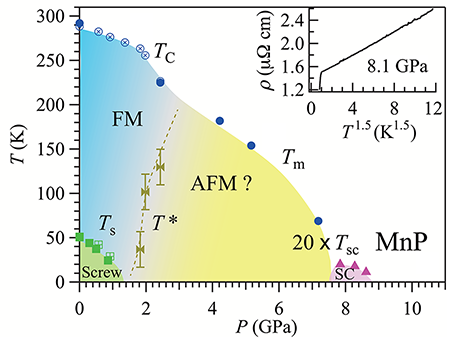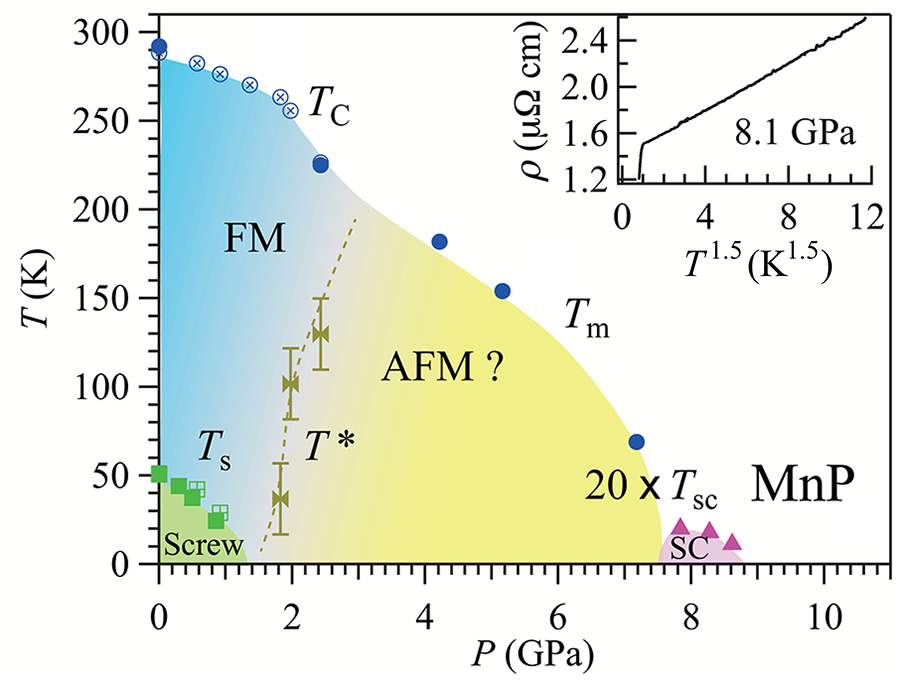Superconductivity with a Twist
Superconductivity and magnetism are typically antithetical forms of order. After all, in conventional superconductors, magnetic impurities are destructive to superconductivity as they break Cooper pairs [1]. But the discovery in 1979 of so-called heavy fermion superconductivity, found near an antiferromagnetic phase, led to a shift in thinking on this subject [2]. Since then, some of the most important classes of superconductors have been found in proximity to magnetism, including not only heavy-fermion superconductors, but also organic superconductors, cuprates, and iron-based superconductors [3]. All of them have similar phase diagrams, in which, either by pressure or chemical substitution, a magnetic phase is suppressed, giving rise to a superconducting phase. This has led to the suggestion that an effective search strategy for discovering new superconductors is to identify a stoichiometric phase that is magnetic, and then find a way to hinder magnetism [4]. Following such an approach, a team led by Jin-Guang Cheng at the Beijing National Laboratory, China, now reports the discovery of the first superconductor based on manganese, an element whose magnetism was thought to be too strong to allow superconductivity. By suppressing magnetism with a large applied pressure, the authors found that manganese phosphide ( MnP) can become superconducting at a critical temperature of 1K.
The emergence of superconductivity in the vicinity of other forms of electronic order, like magnetism, is at the heart of unconventional superconductivity—in which Cooper pairing is not driven by electron-phonon interactions, as it is in “conventional” superconductors. Superconductivity has been found, for instance, in a number of compounds involving 3d transition-metal ions (like iron and copper), whose unpaired d electrons give rise to magnetic behavior. Until recently, Cr and Mn were the only exceptions, which motivated the search for superconductivity in materials containing these elements. Last year, the Beijing group and another group in Kobe, Japan, identified superconductivity in CrAs, a “helical” magnet, in which the arrangement of magnetic spins forms a helix. Superconductivity was induced by pressurizing the material to suppress an antiferromagnetic magnetic phase [5,6]. Although the superconducting transition temperature Tc was low ( 2K), their result inspired researchers to look for superconductivity in related materials. This was found in K2Cr3As3 a “quasi-one-dimensional” structure (its crystal lattice is formed by well-separated Cr- As chains) with a Tc of 6K under ambient pressure [7].
Now, Cheng and co-workers report the discovery of pressure-induced superconductivity in another helical magnet, MnP[8]. These authors measured the resistivity and ac magnetic susceptibility as a function of temperature, from 50 millikelvin to room temperature, and pressures ranging from ambient to 10 gigapascals (GPa). This allowed them to construct a complete pressure-temperature phase diagram for the material (see Fig. 1). In a narrow region close to a critical pressure of 8GPa where magnetism disappears, a superconducting phase is found below 1K. This was evidenced by a drop in the resistivity and a perfect diamagnetic response, which arises from the superconductor’s ability to expel a magnetic field. The latter indicates a large ( 95%) superconducting volume fraction, ruling out the possibility that superconductivity occurs only in local filaments or impurity phases within the material.
We still know little about the nature and origin of the newly found superconducting phase, but the authors’ results suggest that common mechanisms are at play in MnP and CrAs. Like CrAs, the application of pressure in MnP leads to a “quantum critical point” in which the transition to a magnetic phase occurs at zero temperature. Around this critical point, the resistivity should have an unusual temperature dependence scaling as T3/2, exactly as observed in MnP and CrAs. This scaling is a consequence of electron scattering from quantum spin fluctuations. It is from this unusual state that the superconductivity emerges. In both materials, the close proximity of superconductivity to a magnetic instability suggests an unconventional pairing mechanism, perhaps driven by the quantum-critical spin fluctuations. In CrAs, experiments are starting to provide hints of underlying physics different from that of conventional s-wave superconductors: nuclear magnetic resonance (NMR) data show a power-law ( T3) behavior of the spin relaxation rate 1/T1 at low temperatures. This is consistent with a superconducting order parameter of nontrivial symmetry where the energy gap vanishes for certain momenta on the Fermi surface [9]. Similar NMR studies on MnP would be desirable, as well as inelastic neutron scattering studies to determine the nature of the magnetic fluctuation spectrum that could be driving the pairing.
Interestingly, one can contrast the observation of superconductivity in CrAs and MnP with its absence in the prototypical helimagnet, MnSi. In this material, pressure suppresses magnetism, and the resistivity varies as T3/2 over an extended pressure range, but experiments have seen no hint of superconductivity down to the lowest temperatures experimentally accessible [10]. The reason could perhaps be related to the crystal structure. CrAs and MnP have structures that preserve inversion symmetry, whereas MnSi does not. Inversion breaking leads to a mixing of singlet and triplet pairs, and the admixture of the odd-parity triplet could be destructive to superconductivity [1]. A systematic comparison of CrAs and MnP with MnSi, the most studied material of the three [11], could be quite instructive.
Over the years, researchers have gathered important information about the interplay between regular magnetism and superconductivity in conventional and unconventional superconductors. But much less is known about superconductivity in a helical magnet. CrAs and MnP are thus important model systems for such studies, although the high pressures needed to reach the superconducting phase will pose a challenge. Future experiments should lead to a better understanding of the interplay of helical magnetism and superconductivity. Researchers could, for instance, test whether spin fluctuations associated with helical order play any role in the mechanism driving superconductivity. High-pressure neutron scattering studies of static magnetism in CrAs have already indicated a coexistence of superconductivity and magnetism [12]. Certainly, the present paper [8] confirms that, contrary to the beliefs of the “old days” of superconductivity, looking for superconductivity in the vicinity of magnetism can indeed be an effective search strategy for finding new superconductors.
This research is published in Physical Review Letters.
References
- A. A. Abrikosov and L. P. Gor’kov, “Contribution to the Theory of Superconducting Alloys with Paramagnetic Impurities,” Sov. Phys. JETP 12, 1243 (1961)
- F. Steglich, J. Aarts, C. D. Bredl, W. Lieke, D. Meschede, W. Franz, and H. Schafer, “Superconductivity in the Presence of Strong Pauli Paramagnetism: CeCu2Si2,” Phys. Rev. Lett. 43, 1892 (1979)
- M. R. Norman, “The Challenge of Unconventional Superconductivity,” Science 332, 196 (2011)
- N. D. Mathur, F. M. Grosche, S. R. Julian, I. R. Walker, D. M. Freye, R. K. W. Haselwimmer, and G. G. Lonzarich, “Magnetically Mediated Superconductivity in Heavy Fermion Compounds,” Nature 394, 39 (1998)
- W. Wu, J. Cheng, K. Matsubayashi, P. Kong, F. Lin, C. Jin, N. Wang, Y. Uwatoko, and J. Luo, “Superconductivity in the Vicinity of Antiferromagnetic Order in CrAs,” Nature Commun. 5, 5508 (2014)
- H. Kotegawa, S. Nakahara, H. Tou, and H. Sugawara “Superconductivity of 2.2 K under Pressure in Helimagnet CrAs,” J. Phys. Soc. Jpn. 83, 093702 (2014)
- J.-K. Bao, J.-J. Lin, C.-W. Ma, Z.-H. Meng, Y.-L. Sun, H.-F. Zhai, H. Jiang, H. Bai, C.-M. Feng, Z.-A. Xu, and G.-H. Cao, “Superconductivity in Quasi-One-Dimensional K2Cr3As3 with Significant Electron Correlations,” Phys. Rev. X 5, 011013 (2015)
- J.-G. Cheng, K. Matsubayashi, W. Wu, J. P. Sun, F. K. Lin, J. L. Luo, and Y. Uwatoko, “Pressure Induced Superconductivity on the border of Magnetic Order in MnP,” Phys. Rev. Lett. 114, 117001 (2015)
- H. Kotegawa, H. Tou, H. Sugawara, and H. Harima, ”Unconventional Superconductivity in the Vicinity of Strong First-Order Helimagnetic Transition in CrAs: 75As-Nuclear Quadrupole Resonance Study,” Phys. Rev. Lett. (to be published); arXiv:1408.3185 (2014)
- N. Doiron-Leyraud, I. R. Walker, L. Taillefer, M. J. Steiner, S. R. Julian, and G. G. Lonzarich, “Fermi-Liquid Breakdown in the Paramagnetic Phase of a Pure Metal,” Nature 425, 595 (2003)
- S. Muhlbauer, B. Binz, F. Jonietz, C. Pfleiderer, A. Rosch, A. Neubauer, R. Georgii, and P. Böni, “Skyrmion Lattice in a Chiral Magnet,” Science 323, 915 (2009)
- L. Keller, J. S. White, M. Frontzek, P. Babkevich, M. A. Susner, Z. C. Sims, A. S. Sefat, H. M. Rønnow, and Ch. Ruegg, “Pressure Dependence of the Magnetic Order in CrAs: A Neutron Diffraction Investigation,” Phys. Rev. B 91, 020409 (2015)





